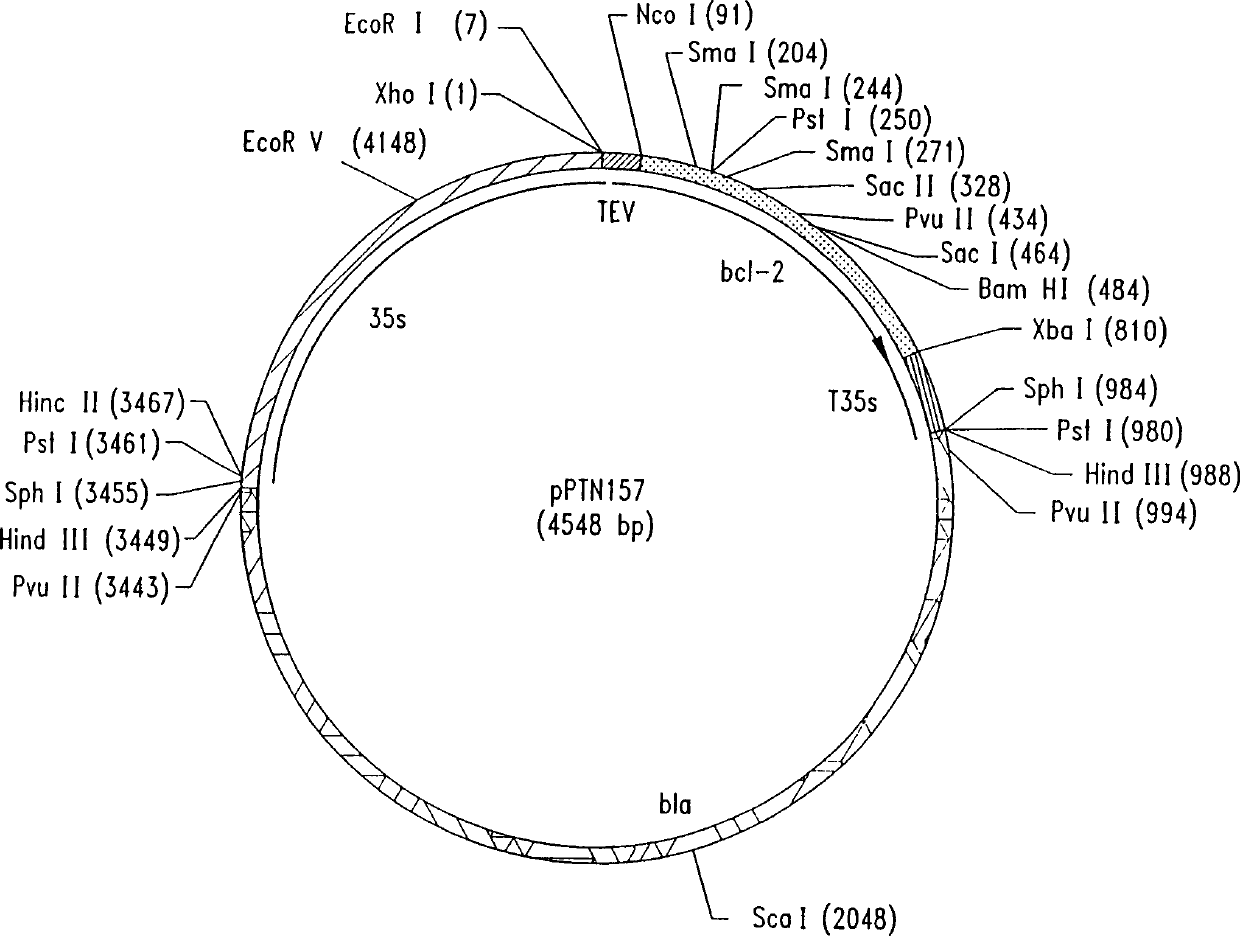Trans-species transfer of apoptotic genes and transgenic plants developed thereby
A technology of transgenic plants and cells, which is applied in the field of modulating plant cell apoptosis, can solve problems such as uncertain relations at best, and achieve the effects of extending shelf life, improving viability, and increasing crop yield
- Summary
- Abstract
- Description
- Claims
- Application Information
AI Technical Summary
Problems solved by technology
Method used
Image
Examples
Embodiment Embodiment I
[0165] The following examples are intended to illustrate rather than limit the invention. Examples Example I Construction of a binary vector containing IAP
[0166]The open reading frame (ORF) in the vector pOPIAPRC (Birmbaum et al., J. of Virology 68:2521-2528, 1994) was modified by PCR to introduce the NcoI site at the 5'end and the BamHI site at the 3'end point. This operation introduces an Ala residue between the Met (position 1) and Ser (position 2) residues of the natural protein. The PCR conditions used were as follows: 1 minute at 94°C; 1 minute at 45°C; 2 minutes at 72°C for 2 cycles, followed by another 1 minute at 94°C; 1 minute at 55°C; and 2 minutes at 72°C for 35 cycles. Primer prc-5: 5'-gttgcagaccatggccagctcccgagcattggc-3'. Primer pre-3: 5'-ttttggatccttttattgttacacttgg-3'
[0167] The PCR product was digested with NcoI and BamHI and subcloned into the plant expression cassette pRTL2 (described as pRTLGUS by Carrington et al., Journal of Virology 64:1590-1597, 1990)....
Embodiment II
[0167] The PCR product was digested with NcoI and BamHI and subcloned into the plant expression cassette pRTL2 (described as pRTLGUS by Carrington et al., Journal of Virology 64:1590-1597, 1990). The resulting vector was called pPTN144 (Figure 1A). The 35S-IAP cassette of pPTN144 was subcloned into the binary vector pZP212 using HindIII (Hajdukiewicz et al., Plant Mol. Bio. 25:989-994, 1994). The resulting vector was called pPTN 148 (Figure 1B). Example II Construction of a binary vector containing Ced-9
[0168] The ORF of Ced-9 was modified by PCR to introduce the NcoI site at the 5'end and the XbaI site at the 3'end. This operation introduces an Ala residue between the Met (position 1) and Thr (position 2) residues of the natural protein. The PCR conditions are the same as those used to transform the pOPIAPRC ORF. Primer ced-5: 5'-gaattccggtttgagccatggcgacacgctgcacggcg-3' primer ced-3-2: 5'-ttttttctagaaatacgttacttcaagctg-3'
[0169] The PCR product was digested with NcoI and Xb...
Embodiment III
[0169] The PCR product was digested with NcoI and XbaI and subcloned into the plant expression cassette pRTL2 (Carrington et al., Journal of Virology 64:1590-1597, 1990). The resulting vector was called pPTN143 (Figure 3A). The ced-9 plant expression cassette of pPTN143 was subcloned as a HindIII fragment into the binary vector pZP212 (Hajdukiewicz et al., Plant Molecular Biology 25:989-994, 1994). The resulting vector was called pPTN 147 (Figure 3B). Example III Construction of a binary vector containing Bcl-2
[0170] The bcl-2 cDNA was modified to introduce the NcoI site at the 5'end of the bcl-2 ORF and the XbaI site at the 3'end of the ORF. Using the same conditions as in Example I, the PCR reaction was carried out with the following primers: primer Bcl2-5: 5'-tttttcctctgggagggccatggcgcacgctgg-3' primer Bcl2-3: 5'-ttttttctagatgctcttcgggcgtgg-3'
[0171] This operation introduces Ala residues between the Met (position 1) and His (position 2) residues of the natural protein. Th...
PUM
 Login to View More
Login to View More Abstract
Description
Claims
Application Information
 Login to View More
Login to View More - R&D
- Intellectual Property
- Life Sciences
- Materials
- Tech Scout
- Unparalleled Data Quality
- Higher Quality Content
- 60% Fewer Hallucinations
Browse by: Latest US Patents, China's latest patents, Technical Efficacy Thesaurus, Application Domain, Technology Topic, Popular Technical Reports.
© 2025 PatSnap. All rights reserved.Legal|Privacy policy|Modern Slavery Act Transparency Statement|Sitemap|About US| Contact US: help@patsnap.com



